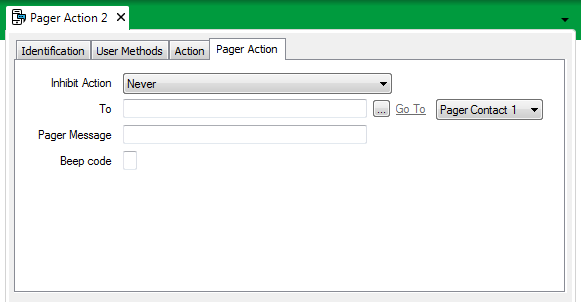You can redirect alarms so that they are sent as text messages to the pager or mobile phone of an engineer, or group of engineers (see Pager/SMS Redirection). To do this you use a Pager Action.
To successfully redirect an alarm in a text message:
- The intended recipient(s) must have:
- Valid Pager Accounts (see Define the E-Mail, Pager, and Voicemail Contact Settings for a User in the ClearSCADA Guide to Security).
- The security permissions required to acknowledge the alarm (see Allocating Security Permissions in the ClearSCADA Guide to Security).
To send the same text message to multiple users:
- Suitable User Groups and/or User Rosters have to exist in the database (see User Groups in the ClearSCADA Guide to Security, and see Configure a User Roster in this guide)
- Each user has to be a member of the relevant User Group (see Associate a User with a User Group in the ClearSCADA Guide to Security).
- Each user in a User Group and/or User Roster has to be configured to receive the e-mails via the same Pager Contact number (either 1, 2, 3, or 4) (see Define the E-Mail, Pager, and Voicemail Contact Settings for a User in the ClearSCADA Guide to Security).
You can use the Pager Action Form’s Pager Action tab to define:
- Whether the pager message should only be sent to recipients that are logged onto the ClearSCADA system
- The recipient(s) of the message
- The contact account to which to send the message
- The message content
- Any audible indication that a message has been delivered.
Configure each Pager Action so that the correct engineer receives the pager message, and the message contains the relevant information.
To define a Pager Action’s details:
- Display the Action Form for the Pager Action that you want to configure.
- Select the Pager Action tab.

- Use the Inhibit Action combo box to define under what circumstances ClearSCADA should be inhibited from sending the pager message:
- Never—Send the message to each of the users listed in the To field, regardless of whether those users are logged on to the system.
- If actioned users are logged on—Send the message to those users listed in the To field, who are not logged on to the system.
- If actioned users are logged on from a WebX client—Send the message to those users listed in the To field, who are not logged on to the system from a WebX client.
- If actioned users are logged on from a ViewX client—Send the message to those users listed in the To field, who are not logged on to the system from ViewX.
- Select the browse button adjacent to the To field.
A Reference browse window is displayed. - Use the Reference browse window to locate the user name of the required recipient user.
- Select the required User name, User Group, or User Roster. (For further information, see User Accounts in the ClearSCADA Guide to Security; see User Groups in the ClearSCADA Guide to Security; or see Configure a User Roster.)
NOTE: Only users for which Pager Account details have been configured are valid (see Define the E-Mail, Pager, and Voicemail Contact Settings for a User in the ClearSCADA Guide to Security).
- Select the OK button.
The Reference browse window is closed and the selected user name is shown in the To field. - Use the Pager Contact combo box to specify to which pager contact account the message is to be sent. (Each user can be allocated up to four pager IDs and services through which they can be contacted. Each ID and service is allocated to a separate Pager Contact Account—see Creating a User Account in the ClearSCADA Guide to Security).
 WARNING
WARNINGMISDIRECTED ALARM NOTIFICATIONS
When configuring ClearSCADA to redirect alarms to a User Group or User Roster, ensure that each user account in that User Group or User Roster is configured to receive messages via the specified Pager Contact number (1, 2, 3, or 4).Failure to follow these instructions can result in death, serious injury, or equipment damage. - Select the Pager Message field.
- Enter the pager message. This can include both plain text and trip characters (see Trip Sequences Supported by Redirection Actions).
The maximum message length is defined using a field on the Form for the Pager Service used by the recipient of the message. Should a pager message exceed this limit, the message is either de-vowelled or truncated, as defined on that Form (see the ClearSCADA Guide to the Pager Driver).
- For Multitone Pager Services, enter the Beep Code for the required audible signal that indicates to the recipient that a message has arrived.
Refer to the documentation supplied with your Pager system for details of the Beep Codes that apply.
- Save the configuration (see Saving Configuration Changes in the ClearSCADA Guide to Core Configuration).
When you have configured the required Pager Actions, you can proceed to Configure Alarm Redirections for an Item or Group.
If your ClearSCADA system is running the Pager driver and is configured to send and receive SMS messages, ClearSCADA can be configured to enable users to trigger actions remotely via SMS. So, for instance, on receipt of an SMS alarm message generated using a Pager redirection action, a user might opt to trigger an action remotely to correct the cause of the alarm. For more information, see the ClearSCADA Guide to the Pager Driver.